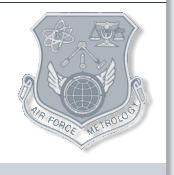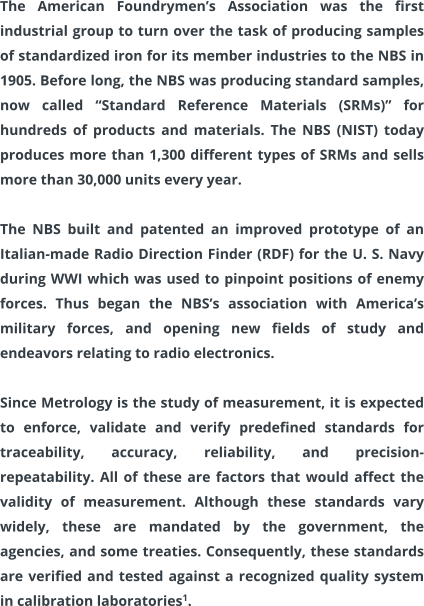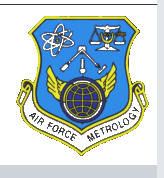



“Illegitimi Non Carborundum”
Last Updated: 11/21/2017 13:15

METROLOGY, page 2
Metrology and the United States Air Force
Organizational
structures
were
put
in
place
to
develop
and
sustain
precision
measurement
capabilities
ensuring
accurate,
reliable,
and
safe
air
and
space
systems
performance
through
effective
management
of
the
Air
Force
Metrology
Program
which
was
initiated
in
January
of
1952
to
comply
with
AF
Regulation
74-2,
which
outlined
policies
and
assigned
responsibilities
for
managing
the
Air
Force Metrology and Calibration Program.
The
Dayton
Air
Force
Depot,
located
at
Gentile
Air
Force
Station
in
Dayton,
Ohio,
was
given
the
authority
to
establish
a
centralized
calibration
program
whereby
Air
Materiel
Area
Depots
were
given
a
set
of
measurement
standards
which
were
periodically
calibrated
by
the
Dayton
Air
Force
Depot
using
standards
traceable
to
the
National
Bureau
of
Standards.
On
15
September
1957
base-level
Precision
Measurement
Equipment
Laboratories
(PMELs)
were
established
providing
the
Air
Force
with
complete
calibration
systems
that
could
handle
the
increasingly
stringent
measurement
needs of new missile
and aircraft systems.
(
Continued
)



“Illegitimi Non
Carborundum”

METROLOGY, page 2
The
American
Foundrymen’s
Association
was
the
first
industrial
group
to
turn
over
the
task
of
producing
samples
of
standardized
iron
for
its
member
industries
to
the
NBS
in
1905.
Before
long,
the
NBS
was
producing
standard
samples,
now
called
“Standard
Reference
Materials
(SRMs)”
for
hundreds
of
products
and
materials.
The
NBS
(NIST)
today
produces
more
than
1,300
different
types
of
SRMs
and sells more than 30,000 units every year.
The
NBS
built
and
patented
an
improved
prototype
of
an
Italian-made
Radio
Direction
Finder
(RDF)
for
the
U.
S.
Navy
during
WWI
which
was
used
to
pinpoint
positions
of
enemy
forces.
Thus
began
the
NBS’s
association
with
America’s
military
forces,
and
opening
new
fields
of
study
and endeavors relating to radio electronics.
Since
Metrology
is
the
study
of
measurement,
it
is
expected
to
enforce,
validate
and
verify
predefined
standards
for
traceability,
accuracy,
reliability,
and
precision-repeatability.
All
of
these
are
factors
that
would
affect
the
validity
of
measurement.
Although
these
standards
vary
widely,
these
are
mandated
by
the
government,
the
agencies,
and
some
treaties.
Consequently,
these
standards
are
verified
and
tested
against
a
recognized
quality
system
in
calibration
laboratories
1
.
Metrology and the United States Air Force
Organizational
structures
were
put
in
place
to
develop
and
sustain
precision
measurement
capabilities
ensuring
accurate,
reliable,
and
safe
air
and
space
systems
performance
through
effective
management
of
the
Air
Force
Metrology
Program
which
was
initiated
in
January
of
1952
to
comply
with
AF
Regulation
74-2,
which
outlined
policies
and
assigned
responsibilities
for
managing
the
Air
Force Metrology and Calibration Program.
The
Dayton
Air
Force
Depot,
located
at
Gentile
Air
Force
Station
in
Dayton,
Ohio,
was
given
the
authority
to
establish
a
centralized
calibration
program
whereby
Air
Materiel
Area
Depots
were
given
a
set
of
measurement
standards
which
were
periodically
calibrated
by
the
Dayton
Air
Force
Depot
using
standards
traceable
to
the
National
Bureau of Standards.
On
15
September
1957
base-level
Precision
Measurement
Equipment
Laboratories
(PMELs)
were
established
providing
the
Air
Force
with
complete
calibration
systems
that
could
handle
the
increasingly
stringent
measurement
needs of new missile
and aircraft systems.
(
Continued
)























